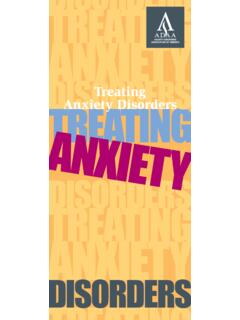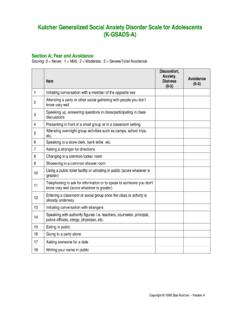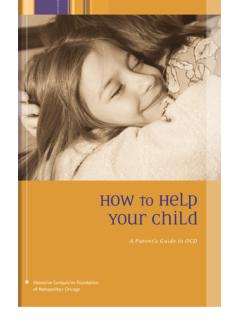Transcription of Symptoms of Generalized Anxiety Disorder Among Adults ...
1 NCHS Data Brief No. 378 September 2020. Symptoms of Generalized Anxiety Disorder Among Adults : United States, 2019. Emily P. Terlizzi, , and Maria A. Villarroel, Generalized Anxiety Disorder (GAD) is characterized by excessive worry Key findings that is difficult to control accompanied by physical Symptoms including Data from the National restlessness, being easily fatigued, difficulty concentrating, irritability, muscle Health Interview Survey tension, or sleep disturbance (1). The GAD 7 scale is a validated brief self- report measure to screen for GAD and assess the severity of Symptoms (2).
2 During 2019, , , Adults with GAD 7 scores of 0 4 are considered to have no or minimal and of Adults experienced Symptoms of GAD, while those with scores of 5 9, 10 14, or 15 21 are mild, moderate, or severe Symptoms of Anxiety in the considered to have mild, moderate, or severe Symptoms , respectively (2). This past 2 weeks, respectively, report examines the percentage of Adults aged 18 and over who experienced while experienced no or Symptoms of Anxiety in the past 2 weeks, by severity of Symptoms and select minimal Symptoms . demographic characteristics, using the GAD 7 scale.
3 The percentage of Adults who experienced mild, Over 15% of Adults experienced Symptoms of Anxiety that moderate, or severe Symptoms were either mild, moderate, or severe in the past 2 weeks. of Anxiety was highest Among those aged 18 29 and decreased with age. Figure 1. Percent distribution of severity of Anxiety Symptoms in the past 2 weeks Among Adults aged 18 and over: United States, 2019. Women were more likely to experience mild, moderate, Moderate Severe or severe Symptoms of Anxiety than men. Mild Non-Hispanic Asian Adults were least likely to experience mild, moderate, or severe Symptoms of Anxiety compared with Hispanic, non-Hispanic white, and non-Hispanic None or minimal black Adults .
4 NOTES: Severity of Anxiety Symptoms was based on the seven-item Generalized Anxiety Disorder scale (GAD 7) and summarized into none or minimal (values 0 4), mild (values 5 9), moderate (values 10 14), and severe (values 15 21). Estimates are based on household interviews of a sample of the civilian noninstitutionalized population. Access data table for Figure 1 at: #1. SOURCE: National Center for Health Statistics, National Health Interview Survey, 2019. DEPARTMENT OF HEALTH AND HUMAN SERVICES. Centers for Disease Control and Prevention National Center for Health Statistics NCHS reports can be downloaded from: NCHS Data Brief No.
5 378 September 2020. During 2019, of Adults aged 18 and over experienced no or minimal Symptoms of Anxiety in the past 2 weeks (Figure 1). Among Adults , experienced mild, experienced moderate, and experienced severe Symptoms of Anxiety . The percentage of Adults who experienced mild, moderate, or severe Symptoms of Anxiety in the past 2 weeks decreased with age. The total percentage of Adults who experienced any Anxiety Symptoms in the past 2 weeks decreased with age, from Among Adults aged 18 29, Among Adults aged 30 44, Among Adults aged 45 64, to Among Adults aged 65 and over (Figure 2).
6 The percentage of Adults who experienced mild Anxiety Symptoms decreased steadily with age, from Among Adults aged 18 29 to Among Adults aged 65 and over. The percentage of Adults who experienced moderate Anxiety Symptoms decreased steadily with age, from Among Adults aged 18 29 to Among Adults aged 65 and over. The percentage of Adults who experienced severe Anxiety Symptoms was lower Among Adults aged 65 and over ( ) compared with Adults aged under 65. Figure 2. Percentage of Adults aged 18 and over who experienced Symptoms of Anxiety in the past 2 weeks, by symptom severity and age group: United States, 2019.
7 18 29 30 44 45 64 65 and over 20 15. Percent 10. 5 0. Any severity1 Mild2 Moderate2 Severe1. 1 Significant quadratic trend (p < ). 2 Significant linear trend (p < ). NOTES: Severity of Anxiety Symptoms was based on the seven-item Generalized Anxiety Disorder scale (GAD 7) and summarized into none or minimal (values 0 4), mild (values 5 9), moderate (values 10 14), and severe (values 15 21). Those categorized as having no or minimal Symptoms of Anxiety are not shown in this figure. Any severity includes those categorized as having either mild, moderate, or severe Symptoms of Anxiety in the past 2 weeks.
8 Estimates are based on household interviews of a sample of the civilian noninstitutionalized population. Access data table for Figure 2 at: #2. SOURCE: National Center for Health Statistics, National Health Interview Survey, 2019. 2 . NCHS Data Brief No. 378 September 2020. Women were more likely than men to experience mild, moderate, or severe Anxiety Symptoms in the past 2 weeks. A total of of women experienced Anxiety Symptoms in the past 2 weeks that were either mild, moderate, or severe, compared with of men (Figure 3). Women were more likely than men to have experienced Anxiety Symptoms that were mild ( and , respectively), moderate ( and ), and severe ( and ).
9 Figure 3. Percentage of Adults aged 18 and over who experienced Symptoms of Anxiety in the past 2 weeks, by symptom severity and sex: United States, 2019. Men Women 20. 15. Percent 10. 5 0. Any severity Mild Moderate Severe 1 Significantly different from women (p < ). NOTES: Severity of Anxiety Symptoms was based on the seven-item Generalized Anxiety Disorder scale (GAD 7) and summarized into none or minimal (values 0 4), mild (values 5 9), moderate (values 10 14), and severe (values 15 21). Those categorized as having no or minimal Symptoms of Anxiety are not shown in this figure.
10 Any severity includes those categorized as having either mild, moderate, or severe Symptoms of Anxiety in the past 2 weeks. Estimates are based on household interviews of a sample of the civilian noninstitutionalized population. Access data table for Figure 3 at: #3. SOURCE: National Center for Health Statistics, National Health Interview Survey, 2019. 3 . NCHS Data Brief No. 378 September 2020. The percentage of Adults who experienced Anxiety Symptoms in the past 2 weeks varied by Hispanic origin and race. Non-Hispanic white Adults ( ) were the most likely to have experienced Symptoms of Anxiety that were either mild, moderate, or severe in the past 2 weeks, and non-Hispanic Asian Adults ( ) were the least likely, compared with Hispanic ( ) and non-Hispanic black ( ) Adults (Figure 4).













